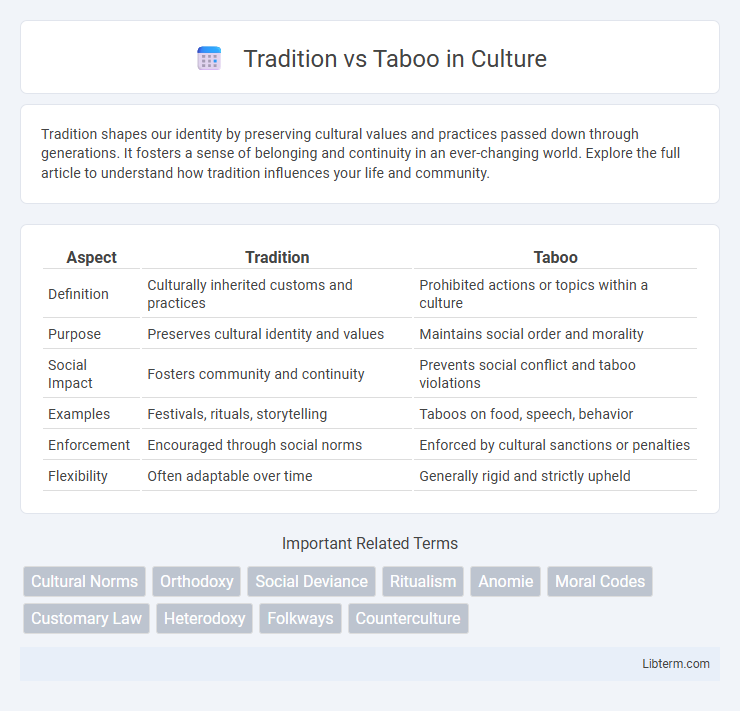Tradition shapes our identity by preserving cultural values and practices passed down through generations. It fosters a sense of belonging and continuity in an ever-changing world. Explore the full article to understand how tradition influences your life and community.
Table of Comparison
| Aspect | Tradition | Taboo |
|---|---|---|
| Definition | Culturally inherited customs and practices | Prohibited actions or topics within a culture |
| Purpose | Preserves cultural identity and values | Maintains social order and morality |
| Social Impact | Fosters community and continuity | Prevents social conflict and taboo violations |
| Examples | Festivals, rituals, storytelling | Taboos on food, speech, behavior |
| Enforcement | Encouraged through social norms | Enforced by cultural sanctions or penalties |
| Flexibility | Often adaptable over time | Generally rigid and strictly upheld |
Understanding Tradition: Roots and Relevance
Tradition embodies the collective customs, beliefs, and practices passed down through generations, shaping cultural identity and societal cohesion. Rooted in historical experiences and communal values, traditions provide a framework for social norms and rituals that reinforce belonging and continuity. Understanding tradition requires recognizing its evolving relevance, balancing preservation with adaptation to contemporary contexts and diverse perspectives.
Defining Taboo: Boundaries of the Unacceptable
Taboo refers to culturally forbidden actions, words, or behaviors that violate social norms and moral boundaries, often rooted in religion, superstition, or social customs. These prohibitions serve to maintain societal order by delineating what is considered unacceptable or sacred, varying significantly across different cultures and historical periods. Understanding taboo involves recognizing its powerful role in shaping identity, social cohesion, and the regulation of taboo subjects such as death, sexuality, and food.
Cultural Clash: When Traditions Become Taboos
Cultural clash emerges when deeply rooted traditions are reinterpreted as taboos within evolving societies, reflecting shifts in collective values and social norms. Practices once revered, such as arranged marriages or certain rites of passage, may face stigmatization, highlighting the tension between heritage preservation and modern ethical standards. This dynamic underscores the complexity of cultural identity as communities negotiate acceptance and rejection of traditional customs in a globalized world.
Evolution of Social Norms: From Tradition to Taboo
The evolution of social norms reflects a dynamic shift where practices once rooted in tradition gradually transform into taboos due to changes in cultural values and collective moral understanding. Historical customs such as arranged marriages or corporal punishment have increasingly faced societal rejection, illustrating this transition. This progression highlights how societies renegotiate acceptable behavior, aligning social conduct with contemporary ethical standards.
The Role of Rituals in Shaping Communities
Rituals serve as foundational practices that reinforce community values and collective identity, often bridging tradition and taboo by codifying acceptable behaviors and social norms. These symbolic acts provide continuity, creating a shared sense of belonging while delineating boundaries that distinguish sacred traditions from forbidden taboos. Through repeated performance, rituals solidify communal cohesion and transmit cultural heritage across generations, shaping social order and individual roles within the community.
Breaking Taboos: Agents of Social Change
Breaking taboos serves as a catalyst for social change by challenging entrenched cultural norms and prompting critical dialogues around issues often deemed controversial. Agents of social change, such as activists, artists, and intellectuals, utilize taboo-breaking as a deliberate strategy to expose injustices, dismantle stereotypes, and foster inclusivity. This transformative process redefines societal values, enabling progress toward greater freedom, equality, and innovation.
Generational Perspective: Old Beliefs vs. Modern Views
Generational perspectives on tradition and taboo reveal a clash between deeply rooted old beliefs and evolving modern views, where older generations often uphold practices as cultural identity markers while younger individuals challenge these norms for inclusivity and progress. Studies show that younger cohorts prioritize personal freedom and question taboos related to gender, sexuality, and social roles, contrasting with elders' emphasis on preserving continuity and moral frameworks. This dynamic tension shapes societal discourse, influencing policy debates and intergenerational communication about cultural values.
Tradition as Identity: Preserving Heritage or Hindrance?
Tradition serves as a vital link to cultural identity, preserving heritage through rituals, language, and customs passed down generations. It fosters community cohesion and a sense of belonging, anchoring individuals in their historical roots. However, rigid adherence to tradition may hinder progress when outdated practices clash with contemporary values and human rights.
Navigating Taboos in a Globalized World
Navigating taboos in a globalized world requires a deep understanding of cultural sensitivity and respect for diverse traditions. Global interconnectedness amplifies encounters with conflicting social norms, necessitating adaptive communication strategies that honor local values while fostering inclusivity. Effective navigation balances preservation of cultural heritage with openness to evolving global perspectives.
Tradition and Taboo: Finding Balance in Modern Society
Traditions shape cultural identity and social cohesion, providing a sense of belonging and continuity across generations. However, taboos challenge these customs by imposing boundaries that prevent harm and promote ethical behavior. Balancing tradition and taboo in modern society requires critical reflection to preserve valuable heritage while adapting norms to contemporary values and human rights.
Tradition Infographic

 libterm.com
libterm.com